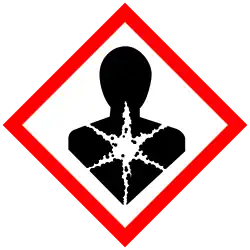4-Vinylcyclohexene
 | |
| Names | |
|---|---|
| Preferred IUPAC name
4-Ethenylcyclohex-1-ene | |
Other names
| |
| Identifiers | |
3D model (JSmol)
|
|
| ChEBI | |
| ChEMBL | |
| ChemSpider | |
| ECHA InfoCard | 100.002.590 |
| EC Number |
|
| KEGG | |
PubChem CID
|
|
| RTECS number |
|
| UNII | |
CompTox Dashboard (EPA)
|
|
| |
| |
| Properties | |
| C8H12 | |
| Molar mass | 108.184 g·mol−1 |
| Appearance | Colorless liquid |
| Density | 0.8299 g/cm3 at 20°C |
| Melting point | −108.9 °C (−164.0 °F; 164.2 K) |
| Boiling point | 128.9 °C (264.0 °F; 402.0 K) |
| 0.05 g/L[1] | |
| Solubility | soluble in benzene, diethyl ether, petroleum ether |
| Vapor pressure | 2 kPa |
Refractive index (nD)
|
1.4639 (20 °C) |
| Hazards | |
| GHS labelling: | |

| |
| Warning | |
| H351 | |
| P201, P202, P281, P308+P313, P405, P501 | |
| NFPA 704 (fire diamond) | |
| Flash point | 21.2 °C (70.2 °F; 294.3 K)[3] |
| 269 °C (516 °F; 542 K) | |
| Lethal dose or concentration (LD, LC): | |
LD50 (median dose)
|
2563 mg/kg (oral, rat)[2] |
| Safety data sheet (SDS) | Oxford University |
| Related compounds | |
Related compounds
|
Buta-1,3-diene Cyclohexene |
Except where otherwise noted, data are given for materials in their standard state (at 25 °C [77 °F], 100 kPa).
Infobox references
| |
4-Vinylcyclohexene is an organic compound consisting of a vinyl group attached to the 4-position of the cyclohexene ring. It is a colorless liquid. Although chiral, it is used mainly as the racemate. It is a precursor to vinylcyclohexene dioxide.[4]
Production
It is produced by buta-1,3-diene dimerization in a Diels-Alder reaction.[5][4] The reaction is conducted at 110 - 425 °C at pressures of 1.3 - 100 MPa in the presence of a catalyst. A mixture of silicon carbide and salts of copper or chromium comprises the catalyst. A competing product is 1,5-cyclooctadiene.
In North America this is produced by Nippon Chemical Texas Inc. in Pasadena, TX.
Safety
4-Vinylcyclohexene is classified as a Group 2B carcinogen by the IARC ("possibly carcinogenic to humans").[3]
References
- ^ Lide, David R. (1998). Handbook of Chemistry and Physics (87 ed.). Boca Raton, Florida: CRC Press. pp. 8–111. ISBN 0-8493-0594-2.
- ^ "Safety (MSDS) data for 4-vinylcyclohexene". Oxford University. Archived from the original on 2010-12-31. Retrieved 2009-04-19.
- ^ a b "4-Vinylcyclohexene" (PDF). IARC. Retrieved 2009-04-19.
- ^ a b Schiffer, Thomas; Oenbrink, Georg. "Cyclododecatriene, Cyclooctadiene, and 4-Vinylcyclohexene". Ullmann's Encyclopedia of Industrial Chemistry. Weinheim: Wiley-VCH. doi:10.1002/14356007.a08_205.pub2. ISBN 978-3-527-30673-2.
- ^ Wittcoff, Harold; Reuben, B. G.; Plotkin, Jeffrey S. (1998). Industrial Organic Chemicals (2 ed.). Wiley-Interscience. pp. 236–7. ISBN 978-0-471-44385-8. Retrieved 2009-04-19.

